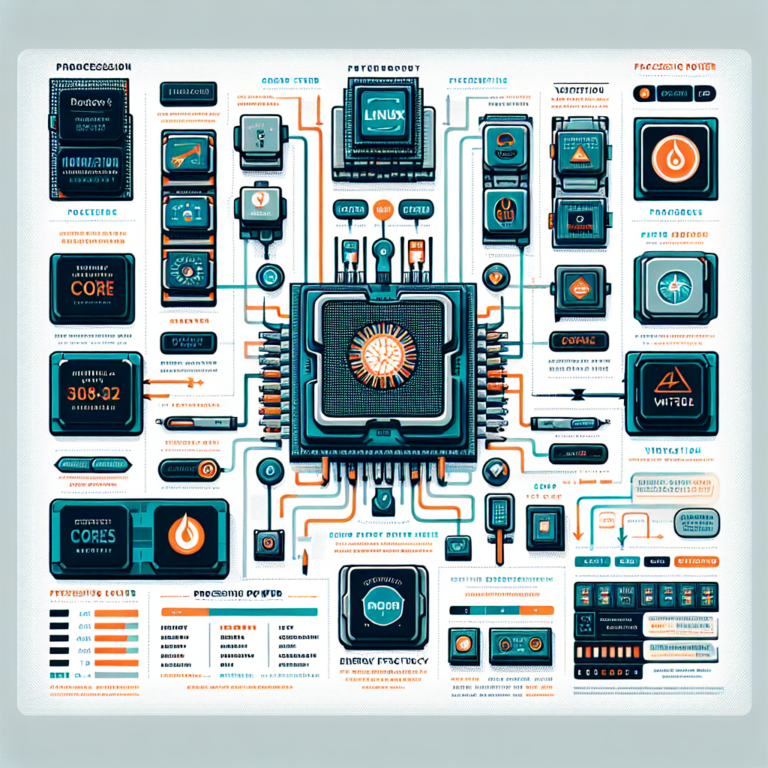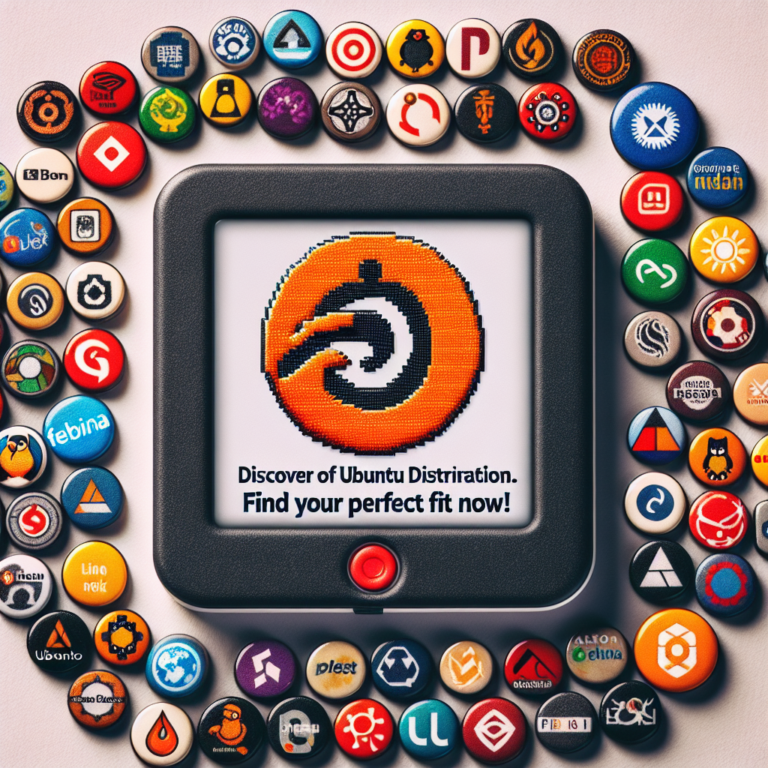Which is the Best Linux Distribution? Top Choices Revealed – Decide Wisely!
Are you looking to dive into the world of Linux but unsure which distribution to choose? With so many options available, it can be overwhelming to decide which one is the best fit for your needs. In this article, we will explore the top Linux distributions and provide detailed insights to help you make an informed decision. Whether you are a beginner or an advanced user, this article will guide you through the best Linux distributions available, allowing you to choose wisely.
1. Ubuntu
Ubuntu is one of the most popular Linux distributions and is known for its user-friendly interface and extensive community support. It is based on Debian and offers a stable and secure operating system. Ubuntu is suitable for both beginners and advanced users, making it a versatile choice for various purposes. It provides a vast software repository, ensuring that you have access to a wide range of applications. Ubuntu also offers long-term support (LTS) versions, which are ideal for those seeking stability and reliability.
Whether you are looking to use Linux for personal use or for enterprise-level applications, Ubuntu is a solid choice. Its intuitive interface, regular updates, and extensive documentation make it a favorite among many users. Ubuntu also has a strong focus on security, ensuring that your system is protected from potential threats. With its large and active community, you can easily find support and solutions to any issues you may encounter.
2. Fedora
Fedora is a cutting-edge Linux distribution that focuses on providing the latest software and technologies. It is backed by Red Hat, a leading company in the open-source community. Fedora is known for its stability, security, and commitment to innovation. It offers a wide range of software packages and is often used by developers and enthusiasts who want to stay at the forefront of technology.
If you are someone who enjoys experimenting with new features and technologies, Fedora is an excellent choice. It provides a solid platform for developers and offers a vast selection of development tools. Fedora also has a strong community presence, with active forums and support channels. However, it may not be the best option for beginners or those seeking long-term stability, as it tends to have more frequent updates and changes.
3. Debian
Debian is one of the oldest and most respected Linux distributions. It is known for its stability, security, and adherence to the principles of free software. Debian is entirely community-driven and has a vast repository of software packages. It offers different editions, including the stable release, which is ideal for those seeking a reliable and secure operating system.
Debian is a versatile distribution that can be used for various purposes, from personal use to server deployments. It provides a robust package management system, making it easy to install and update software. Debian also has a strong focus on security, with regular updates and a dedicated security team. If you value stability and reliability, Debian is an excellent choice.
4. Arch Linux
Arch Linux is a lightweight and flexible distribution that follows a “do-it-yourself” philosophy. It is designed for users who want full control over their system and enjoy customizing every aspect of their Linux experience. Arch Linux provides a minimal base installation and allows users to build their system from the ground up.
If you are an advanced user or a Linux enthusiast who enjoys tinkering with your system, Arch Linux offers a highly customizable and lightweight platform. It provides access to the latest software packages and has an active community that offers support and guidance. However, Arch Linux requires a certain level of technical knowledge and may not be suitable for beginners or those looking for a more user-friendly experience.
5. CentOS
CentOS is a Linux distribution based on the source code of Red Hat Enterprise Linux (RHEL). It is known for its stability, security, and long-term support. CentOS is often used for server deployments and is a popular choice among businesses and organizations.
If you are looking for a reliable and secure operating system for your server, CentOS is an excellent option. It provides regular updates and security patches, ensuring that your system remains protected. CentOS also offers extensive documentation and support, making it easier to set up and manage your server.
6. openSUSE
openSUSE is a community-driven Linux distribution that offers a user-friendly experience and a wide range of software packages. It is known for its stability, security, and ease of use. openSUSE provides different editions, including the Leap edition, which offers a stable and reliable operating system, and the Tumbleweed edition, which provides the latest software updates.
If you are a beginner or someone who values ease of use, openSUSE is a great choice. It offers a polished and intuitive desktop environment and provides a vast selection of software through its package management system. openSUSE also has a strong community presence, with active forums and support channels.
7. Linux Mint
Linux Mint is a user-friendly Linux distribution that aims to provide a familiar and comfortable computing experience. It is based on Ubuntu and offers a highly customizable desktop environment. Linux Mint focuses on simplicity and ease of use, making it an excellent choice for beginners and those transitioning from Windows.
If you are new to Linux or prefer a desktop environment that resembles Windows, Linux Mint is a great option. It provides a straightforward installation process and a user-friendly interface. Linux Mint also includes various multimedia codecs and proprietary software, ensuring that you can enjoy a seamless multimedia experience.
8. Manjaro
Manjaro is a user-friendly Linux distribution that is based on Arch Linux. It aims to provide a stable and easy-to-use operating system while still offering access to the latest software packages. Manjaro focuses on providing a hassle-free experience and includes various tools and utilities to simplify system management.
If you want the benefits of Arch Linux but prefer a more user-friendly approach, Manjaro is an excellent choice. It offers a simple installation process and a preconfigured desktop environment. Manjaro also provides access to the Arch User Repository (AUR), which allows users to easily install and manage additional software packages.
9. Elementary OS
Elementary OS is a Linux distribution that aims to provide a beautiful and intuitive user interface. It is based on Ubuntu and offers a clean and minimalistic desktop environment. Elementary OS focuses on simplicity and ease of use, making it an excellent choice for beginners and those who value aesthetics.
If you are looking for a visually appealing and user-friendly Linux distribution, Elementary OS is worth considering. It provides a consistent and polished user interface and includes various applications designed specifically for the Elementary OS ecosystem.
10. Gentoo
Gentoo is a highly customizable and performance-oriented Linux distribution. It follows a “source-based” approach, allowing users to compile and optimize software specifically for their system. Gentoo is known for its flexibility and control, making it a popular choice among advanced users and enthusiasts.
If you enjoy fine-tuning your system and want complete control over every aspect of your Linux experience, Gentoo is an excellent choice. It provides a vast selection of software packages and allows users to optimize their system for maximum performance.
11. Slackware
Slackware is one of the oldest surviving Linux distributions and is known for its simplicity and stability. It follows a “keep it simple” philosophy and provides a minimalistic and lightweight operating system. Slackware is often used by advanced users and those who prefer a more traditional Linux experience.
If you are an experienced Linux user or prefer a distribution that stays true to the roots of Linux, Slackware is worth considering. It offers a straightforward installation process and a minimalistic desktop environment. Slackware also provides a high level of customization and control over your system.
12. Red Hat Enterprise Linux (RHEL)
Red Hat Enterprise Linux (RHEL) is a commercial Linux distribution that is widely used in enterprise environments. It is known for its stability, security, and long-term support. RHEL offers a robust and reliable platform for mission-critical applications and is backed by Red Hat, a leading company in the open-source community.
If you are looking for a Linux distribution for enterprise-level applications, RHEL is an excellent choice. It provides extensive support and documentation, ensuring that your system remains secure and up to date. RHEL also offers various management tools and services to simplify system administration.
13. Kali Linux
Kali Linux is a specialized Linux distribution that focuses on penetration testing and digital forensics. It is widely used by security professionals and ethical hackers for various security-related tasks. Kali Linux provides a vast collection of tools and utilities for testing the security of networks and systems.
If you are interested in cybersecurity or want to learn more about penetration testing, Kali Linux is the go-to distribution. It offers a comprehensive set of tools and resources for ethical hacking and security testing. However, it may not be suitable for general-purpose use or beginners who are new to Linux.
14. Zorin OS
Zorin OS is a Linux distribution that aims to provide a familiar and user-friendly computing experience. It is designed to resemble the look and feel of Windows, making it an excellent choice for those transitioning from Windows. Zorin OS offers a polished and intuitive desktop environment.
If you are new to Linux or prefer a desktop environment that resembles Windows, Zorin OS is worth considering. It provides a straightforward installation process and includes various applications and tools to enhance productivity.
15. Solus
Solus is a Linux distribution that focuses on providing a curated and user-friendly experience. It offers a unique desktop environment called Budgie, which is designed to be lightweight and intuitive. Solus aims to provide a cohesive and polished user interface.
If you value aesthetics and want a visually appealing Linux distribution, Solus is worth considering. It offers a clean and modern desktop environment and includes various applications and utilities to enhance productivity.
16. MX Linux
MX Linux is a lightweight and efficient Linux distribution that is based on Debian. It aims to provide a stable and easy-to-use operating system while still offering a wide range of software packages. MX Linux is known for its performance and versatility.
If you have older hardware or prefer a lightweight Linux distribution, MX Linux is an excellent choice. It offers a minimalistic desktop environment and includes various tools and utilities to enhance system performance.
17. Pop!_OS
Pop!_OS is a Linux distribution that is developed by System76, a company that specializes in Linux-based hardware. It is based on Ubuntu and offers a user-friendly experience. Pop!_OS focuses on productivity and includes various features and tools to enhance workflow.
If you are a developer or someone who values productivity, Pop!_OS is worth considering. It provides a polished and intuitive desktop environment and includes various development tools and utilities.
18. Antergos
Antergos is a user-friendly Linux distribution that is based on Arch Linux. It aims to provide an easy-to-use operating system while still offering access to the latest software packages. Antergos focuses on simplicity and includes various tools and utilities to simplify system management.
If you want the benefits of Arch Linux but prefer a more user-friendly approach, Antergos is an excellent choice. It offers a simple installation process and a preconfigured desktop environment. Antergos also provides access to the Arch User Repository (AUR), which allows users to easily install and manage additional software packages.
19. Deepin
Deepin is a Linux distribution that aims to provide a beautiful and intuitive user interface. It is known for its visually appealing design and attention to detail. Deepin offers a unique desktop environment and includes various applications and tools to enhance the user experience.
If you value aesthetics and want a visually stunning Linux distribution, Deepin is worth considering. It provides a polished and modern desktop environment and includes various multimedia and productivity applications.
20. Lubuntu
Lubuntu is a lightweight and efficient Linux distribution that is based on Ubuntu. It aims to provide a fast and energy-efficient operating system, making it an excellent choice for older hardware or low-spec systems. Lubuntu offers a minimalistic desktop environment and includes various lightweight applications.
If you have older hardware or prefer a lightweight Linux distribution, Lubuntu is worth considering. It provides a simple and efficient desktop environment and focuses on performance and energy efficiency.
After exploring the top Linux distributions, it is important to note that the “best” distribution ultimately depends on your specific needs and preferences. Consider factors such as your level of experience, intended use, hardware specifications, and desired desktop environment. It is recommended to try out different distributions through live USB or virtual machines to see which one suits you best.
FAQs
1. Which Linux distribution is best for beginners?
For beginners, Ubuntu and Linux Mint are excellent choices. They offer user-friendly interfaces, extensive documentation, and strong community support.
2. Which Linux distribution is best for gaming?
Pop!_OS and Manjaro are popular choices for gaming due to their focus on performance and compatibility with gaming hardware and software.
3. Which Linux distribution is best for servers?
CentOS and Ubuntu Server are widely used for server deployments due to their stability, security, and long-term support.



